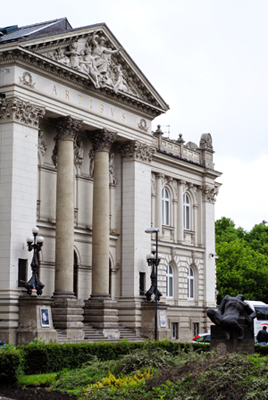
Zachęta National Gallery of Art
PHOTO: Lara Szypszak
Every time I reminisce about my summer interning at Zachęta National Gallery of Art, I think only fondly of Warsaw. My position in the Education Department at the gallery brought me into the depths of the city’s artistic community. I was taken in by a group of creative and open-armed Varsovians who gave me the chance to assist curators and Poland’s major artists first hand, to participate in the development of exhibitions, and they fostered my love of photography, publishing my photos, and choosing me to take photos for Gazeta Wyborcza. I did everything from posting flyers in every corner of the city to assisting Warsaw’s general press. My largest job and most valuable experience was managing the backstage at the music festival The Artists, shuttling performers across the stage and documenting the entire event with my precious camera in hand. Not only did the gallery take care of me, but the curators and artists also wanted to show me what it meant to be a part of this community. I was not there only for professional growth, but for life experience. They accepted me into their family, and I spent my days and nights getting to know Warsaw from the eyes of these Varsovians.
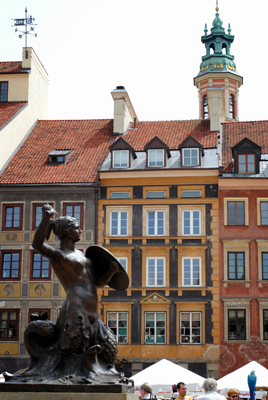
Warsaw’s Syrenka
PHOTO: Lara Szypszak
My colleagues and mentors showed me that Warsaw is the kind of friend who teaches us about life, introduces us to new ideas, and shows us how to enjoy the present without forgetting the past. Warsaw is not without its faults, but never pretends to be something that it is not. Warsaw is honest, creative, and wise. Warsaw is not only one of the most resilient cities in all of history, but also one of the most intriguing. The Warsaw I know today is both the same, and nothing like, that which my own grandfather knew as a young, eager boy excited to skate along the frozen Wisła river. It took some time, but Warsaw activated its natural magnetism, relentlessly seducing me with charm and intrigue, and at last won me over. We are now the greatest of friends.
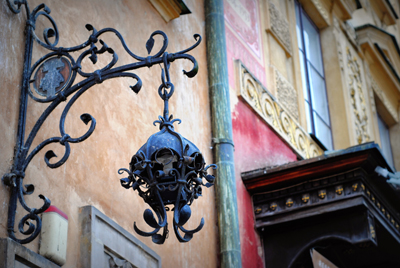
Intricate details in Warsaw’s streets
PHOTO: Lara Szypszak
A few times during my stay, I hosted friends and family in this Syrenka-guarded wonderland. I thought endlessly about how I might introduce them to my new companion; should we cover all the tourist sights, or should I share with them the secrets I had learned from my gallery guardians? Before I divulge my secrets, I must acknowledge that many people know Warsaw very well, and I know they may disagree with my chosen highlights. Warsaw is timeless, an acquaintance to many. These are only fragments of the Warsaw I wish to share with you, and only glimpses of the Warsaw many know and love.
§
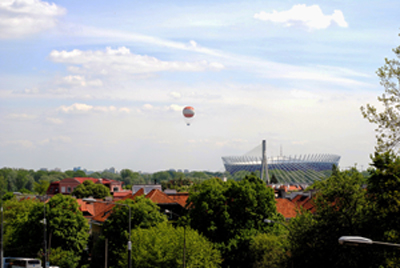
View of Praga and the new Stadium
PHOTO: Lara Szypszak
When Poland co-hosted the Euro Cup in 2012, Warsaw acquired much more than a shiny new stadium. From taking many trips to the airport to pick up artists’ families, I learned that the new direct train to and from the airport to the city center is one of the more outstanding additions. While you may have to lug your suitcase a bit farther than to the bus stop or taxi stand, the price and comfort of the ride is well worth it. This shiny bullet is, more often than not, clean and completely empty, and you avoid both the bus-pickpockets and the taxi-rip-offs. While this route may not provide the same wacky adventure as you would normally have on Bus no. 175, the S2/S3 train ride is a smooth way to enter the city.
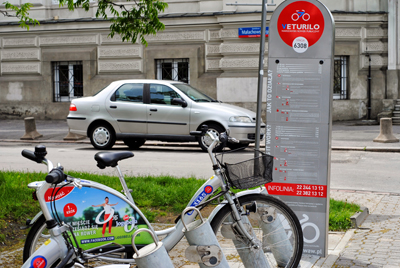
Veturilo bike share program
PHOTO: Lara Szypszak
My favorite in-city transportation, however, is the bike share system, Veturilo. This is how I ran many errands for the gallery, crossing many bridges and navigating through courtyards and along back streets where no buses go. However, this system is not without its mishaps. Occasionally one needs to double check for loose chains and wonky spokes. Fortunately, I learned that many passersby would offer guidance as you struggle to peddle. I certainly had a few amusing encounters with onlookers who felt my biking skills were, shall we say, a bit rusty, especially in the bustling Warsaw streets. One older gentleman saw the beauty in this lack of skills, remarking about one friend of mine, “It is a beautiful thing to watch your friend ride a bicycle!” I saw more of Warsaw on these two wheels than I ever could have on foot, and it was certainly more cinematic this way!
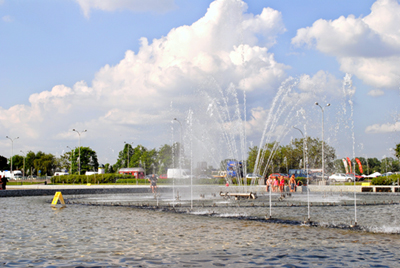
Visitors splash around in the Multimedia Fountain Park on a hot day
PHOTO: Lara Szypszak
I never grow tired of passing along the Wisła, be it by bike or on foot, eyeing the modest menus of the docked-boat restaurants, and watching the dozens of sluggish strollers and peaceful loungers sitting along the water. This is an especially intriguing destination at dusk, as people get happier (read: flirtatious and somewhat intoxicated), taking in the sunset as they listen to a nearby open air concert at Cud nad Wisłą, where a gallery colleague of mine and his band would perform in the evening. While it may seem unconventional, these boat and riverside venues serve some tremendously delicious food, especially grilled kiełbasa. I always head back toward Old Town by taking this back-road riverside route. This way, I end up by the multimedia fountain park, either to cool down and stick my feet in the water, or to watch the dazzling, colorful light show. The view at this spot is spectacular, with the burnt-umber rooftops cascading on the west side, and the river in front on the east. At this point, one seems to be basking in a haze of serene antiquity, which swirls in the mist from the fountain and intoxicates you in the heat of the summer.
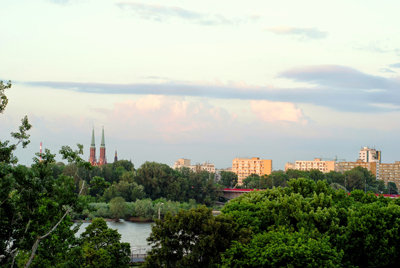
View of Praga’s lush lands from across the river
PHOTO: Lara Szypszak
From Old Town, on a curved outlook, one can see the skyline of the Praga district across the river. It frustrates me that Praga has had a historically bad rap as a seedy area for so many years, leaving much of its treasures unfairly neglected. In truth, this region is blossoming into an artist’s haven! Saska Kępa is a particularly popular neighborhood for the casual stroller to observe beautiful facades, while Skaryszewski Park, situated just past the new National Stadium, offers a space of cascading greenery for nature lovers, a cozy setting for outdoor concerts, and a venue for endless varieties of festivals. I once passed through a rather wacky Smerf Festival while working at a different, more experimental music festival in the park, hosted by Zachęta, The Artists. One of the more intriguing, and still developing, additions in the vicinity is the Soho Factory, an “Avant-garde Space for Culture and Business.” The goal there is to have Warsaw become one of the first European cities to develop a clearly defined neighborhood designated for artistic activity. Clearly, a gallery or theater on nearly every downtown street just was not enough for Warsaw culture addicts.
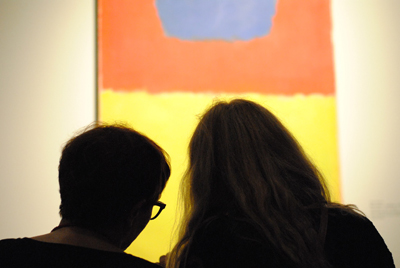
Rothko opening at the National Museum
PHOTO: Lara Szypszak
I inevitably lead my company to Zachęta, my beloved place of work, which always has fascinating exhibitions on display. One major benefit of working at a gallery is my ease of access to intimate museum and arts events all around Warsaw. This is how I almost collided head-on with President Komorowski and his wife at the Mark Rothko exhibition opening at the National Museum. Aside from the Night of Museums, a carnival-esque, mid-May night when galleries and museums throughout the city are open for free and until very late, any visitor can enter these institutions free on a designated day. [For example, Zachęta is free on Thursdays, the National Museum on Tuesdays, the Frederyk Chopin Museum and the Warsaw Uprising Museum on Sundays, and so on.] A good number of these large galleries also have tiny, off-site spaces that are interesting to explore. I learned that the Bec Zmiana Foundation is a great source for finding out about artistic happenings around Warsaw and greater Poland. At night, many gallery spaces often turn into an alluring performance venue, a thumping dance floor, or perhaps an artist has something entirely unpredictable up his/her sleeve for a basement hall.
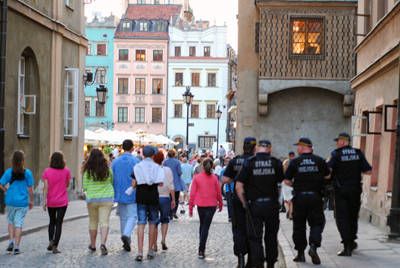
The crowd at the start of Night of Museums 2013
PHOTO: Lara Szypszak
Planning meals for a weekend visitor is always difficult for me because there are just so much choices. While the milk bars scattered throughout the city streets offer dirt-cheap lunches and taste like heaven, especially Bar Mleczny: Familijny (my goodness do the locals flock here!), I am inclined to lead my visitors away from the main restaurants along Nowy Świat/Krakowskie Przedmieście. The several blocks south of Aleje Jerozolimskie have dozens upon dozens of restaurants, bars, and cafes, food from every culture you can think of, and is relatively devoid of major tourist crowds. While not the “authentic Polish cuisine” some may be looking for, gallery interns flock to Bobby Burger after events. This joint has some of the best, juicy, and flavorful hamburgers around. The Tel-Aviv Café and Deli, home to some of the most delicious sandwiches and creative, refreshing drinks was always a great place to take a break from plastering posters. The young, fashionable crowd that circuits these streets is an added attraction.

Viewers at the Ethnographic Museum during the 2013 Night of Museums
PHOTO: Lara Szypszak
On a rainy afternoon, or after a long day of wandering, I often like to wind down with a warm mug of tea or coffee. My gallery friends would take me to the cozy bookstore/coffee shop Wrzenie świata, on Gałczynskiego. Every time I settled in for a large, affordable, cup of brew, I spotted a well-known artist or curator (I feel the need to name-drop, here, the alluring Michał Libera), or observed someone that looked to be penning the next great contemporary Polish novel. It is a wonderful place to sit, chat, and reflect on all that I had done that day. The bookshelves seemed to be hugging me, inviting me to stay longer, wanting me to revel in the friendship that is Warsaw and me.
CR
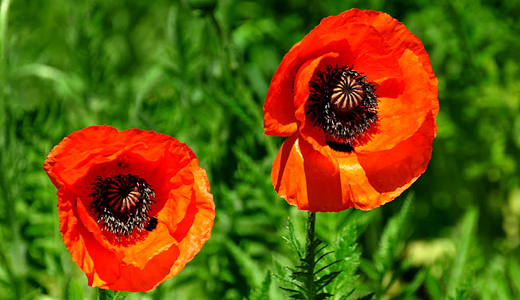
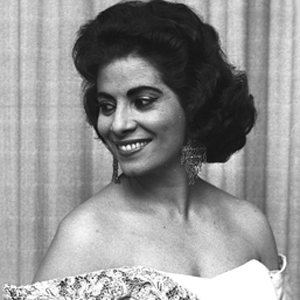
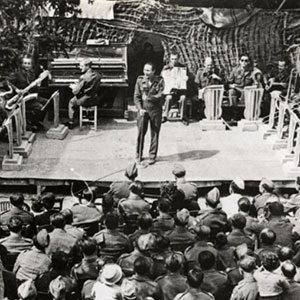
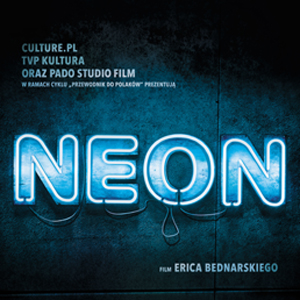
Pingback: Welcome to our Summer 2014 issue!
Thank you for such a lovely pictorial article!